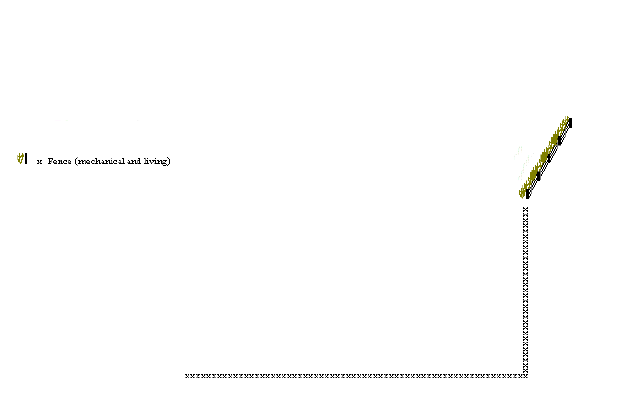


The productive forestry plantation models were designed for upper sandy foot slopes with groundwater level at 2.5 - 4 m. These models are composed of block plantations of poplars, pines and native species intercalated with belts of shrubs.
Timber and fuelwood production as well as providing environmental protection through permanent forest cover, with additional fodder and fuelwood production from the shrubs.
The same approach was used for financial analysis on the productive plantation models with the agro-forestry models. The results are summarized as the following table.
Table 3: Financial efficiency of productive plantation models
Model |
Site Class |
Model Rotation(years) |
IRR(%) |
NPV at 12% (yuan/ha) |
PP1 |
3 |
15 |
18% |
2122 |
PP2 |
3 |
15 |
22% |
2575 |
PP3 |
3 |
40 |
9% |
-1099 |
PP4 |
3 |
40 |
16% |
1539 |
According to the results of the financial analysis criteria of IRR and NPV, model PP1, PP2 and PP4 are financially positive to the farmers or investors. Model PP3 is financially negative and will not be accepted by the farmers or investors since its IRR is less than 12% and its NPV is below zero.
Model PP2 is designed as large productive shelterbelts of Poplar, with possibly rainfed agriculture or fodder production. 0.57 ha of Poplar has been taken into account in the 1 ha model while the other 0.43 ha could be used for rainfed crop production and was not taken into account in the financial analysis. The value of NPV for model PP2 is only refers to 0.57 ha's Poplar plantation.
Assuming that all the four productive plantation models are options for the same circumstances, as they are all for site class 3, Model PP1 and PP2 are better than model PP3 and PP4. In other words, Poplar plantation is more attractive than Pine or native species plantation to farmers and investors.
With a 20% decline in products price or yield, the major sensitivity results for model PP1, PP2 and PP4 are shown below:
The sensitive analysis result shows that all the three models, which are financially positive, are still substantial with price or yield decline of 20% as well.
Table 4 : Sensitivity analysis of the Productive Plantation models assumming a decline of 20% in outputs (yields and/or prices)
Model |
IRR with decline in outputs of 20% (%) |
NPV with ecline in outputs of 20% (in Yuan RMB) |
PP1 |
15 |
905 |
PP2 |
18 |
1368 |
PP4 |
14 |
521 |
On the following pages a description is provided for each of the Productive Plantation models.
1. Suitable site class: 3 - on upper sandy foot slopes (with groundwater level at 2.5-4 m)
2. Description: This model proposes block plantations of poplars, intercalated with single rows of shrubs.
3. Objectives: Timber and fuel wood production as well as providing environmental protection through permanent forest cover, with additional fodder and fuel wood production from the shrubs.
4. Design: Block plantations of different selected clones of poplar planted in rows separated each 5 rows by a row of shrubs.
5. Species to be used: different selected clones of Populus, leguminous shrubs as Lespedeza bicolor for the intercalating shrubs.
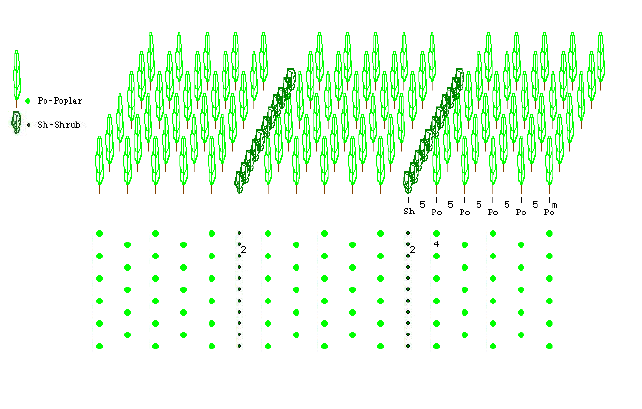
1. Suitable site class: 3 - on upper sandy foot slopes (with groundwater level at 2.5-4 m)
2. Description: This model proposes large productive shelterbelts of poplars, with possibility for rain fed crop production in between the belts.
3. Objectives: Timber and fuel wood production as well as providing environmental protection, in particular wind protection for rain fed crops improving production.
4. Design: Shelterbelts composed of different selected clones of poplar with a total width of 40 m, alternated with belts of 30m where, eventually, rain fed crops could be cultivated; maximum height of the shelterbelt is expected to reach 12-15m after 10 to 15 years.
The shelterbelt will be directed NE-SW, perpendicular to the main NW wind direction. It will be composed of 10 rows of poplar (in a mosaic of mixed clones), 4 m apart of each other. Poplar will be at a distance of 3 m in the row. In the intervals rainfed cropping can be done (agriculture or other).
5. Species to be used: different selected clones of Populus
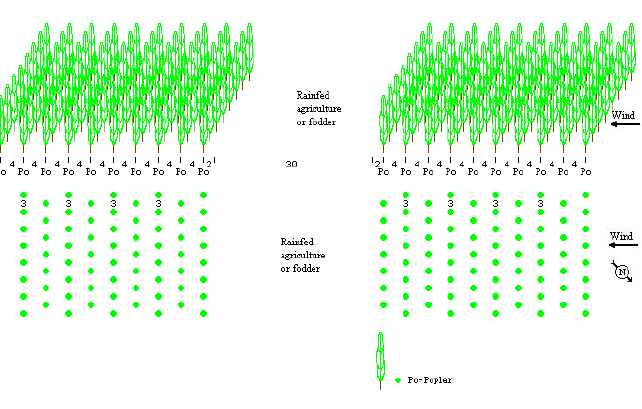
1. Suitable site class: 3 - on upper sandy foot slopes (with groundwater level at 2.5-4 m) with non-alkaline soils
2. Description: This model proposes block plantations of pines, intercalated with double rows of shrubs.
3. Objectives: Timber and fuel wood production as well as providing environmental protection through permanent forest cover, with additional fodder and fuel wood production from the shrubs.
4. Design: Block plantations of different selected provenances of pines planted in rows alternating, each 4 rows of pine, with 2 rows of shrubs.
5. Species to be used: different selected provenances and species of Pinus, leguminous shrubs as Amorpha fruticosa for the intercalating shrubs.

1. Suitable site class: 3 - on upper sandy foot slopes (with groundwater level at 2.5-4 m)
2. Description: This model proposes block plantations in alternating belts composed of poplars, pines and native species.
3. Objectives: Timber and fuel wood production as well as providing environmental protection through permanent diversified forest cover, with some additional fodder and fuel wood production.
4. Design: Mixed plantations in belts composed of different species. 6 rows of poplars with a spacing of 5 x 5 m are alternating with 4 rows of conifers (spacing 4 x 4m) and 4 rows of native species, 4 x 3 m apart.
5. Species to be used: different selected clones of Populus, selected provenances of Pinus or, eventually, other adapted conifers like Picea mongolica and Larix sp., native species like Salix matsudana, Ulmus sp., Acer sp., Prunus armeniaca, ...
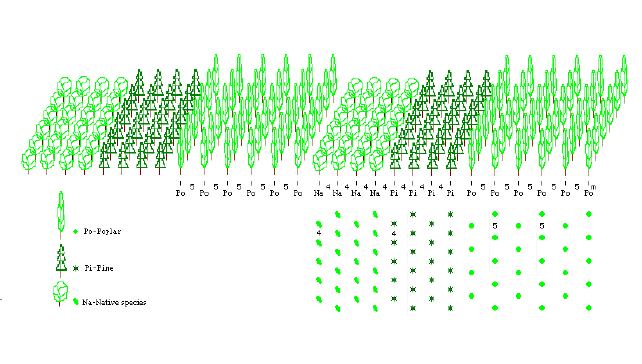
Revegetation models were developed for degraded sandsheet/dunes with groundwater level at more than 4 m, combined with rapidly degrading original sandsheet with dark topsoil, moving sand dunes or where moving sand dunes are invading. The models are composed of shrubs and trees. The single most important management tool is the fencing-off of the areas, with a combination of mechanical and living fences.
Environmental protection, restoration of natural elm woodland or natural grassland with eventually some wood, fruit, crop, or fodder production.
As the main purpose of these models is revegetation rather than timber or cash crop production and the revenue from trees and crops is extremely low because of the advanced degradation of the land, the model rotation is identified mainly based on the time needed for the establishment of the revegetation cover. Over the remainder of time after establishment, it is assumed that the annual maintenance cost is equal to the benefits obtained from possible fodder or fuel wood production and medicinal herbs recollection.
The NPV for each model was calculated and is summarized in Table 5.
Table 5 : Financial efficiency of the revegetation models
Model |
Site Class |
Model Rotation(years) |
NPV at 12% (yuan/ha) |
RV1 |
4 |
25 |
-1887 |
RV2 |
4 |
25 |
-2021 |
RV3 |
4 |
10 |
-1024 |
RV4 |
2, 3 |
25 |
-1878 |
RV5 |
4 |
25 |
-1850 |
RV6 |
4 |
10 |
-1596 |
RV7 |
4 |
10 |
-1346 |
RV8 |
4 |
10 |
-1266 |
As mentioned above, those models mainly provide environmental benefits with little contribution to marketable production. All the NPVs are negative and indicate that the revegetation model are not attractive to farmers and investors from the financial point of view.
From another perspective, the negative NPVs provide a base for the adjustment of subsidies or public financial input in order to stimulate the farmer's participation, since the main objective of these models should be realized by the Government.
Further, if the objectives of the models obey to policies and laws established by the Government, the models with the comparative higher NPV should be considered for implementation.
Further analysis was made in the following comparative analysis.
Assuming that models RV1, RV2, RV3 and RV6 are options for implementation under similar conditions (degraded sandsheet/dunes), RV3 has the highest NPV and is the best among the four. In other words, the model RV3 will cost to the farmers or investors, or to the Government, the least to achieve the objective.
By taking the same approach, model RV8 among model RV5, RV7 and RV8 is identified as the best model if those models will play the same role in environmental protection.
Based on the above analysis results, it is concluded that models composed of shrubs and trees are better options than models with fruit trees. The latter need more inputs but without efficient outputs from the financial point of view.
On the following pages a description of the different revegetation models is provided.
1. Suitable site class: 4 - degraded sandsheet/dunes with groundwater level at more than 4m, combined with rapidly degrading original sandsheet with dark topsoil: remnants of the original "savanna"-like elm woodland, extensive open blocks of permanent agricultural land and traditional communal grazing lands.
2. Description: This model proposes patches (small blocks) of almond trees in natural grassland.
3. Objectives: Environmental protection, restoration of natural grassland with eventually a cash crop production (almonds).
4. Design: Small blocks of Prunus armeniaca (12 trees), planted 3 x 5 m in the blocks with the blocks 10 m apart. Crossed belts of 1 row of Lespedeza, 1 m apart in the row, could be installed in between the patches. Design will be irregular and depend on the spatial distribution of suitable micro-sites for Prunus. Mechanical fencing has to be included in the model in order to protect the natural regeneration of the grassland against grazing animals. Living fences should be installed in order to replace the mechanical fence after a few years.
5. Species to be used: Prunus armeniaca var. ansu (provenance of Zhalute Banner) as fruit tree species, shrubs as Lespedeza bicolor, ... and living fence species as Caragana microphylla, Gleditsia japonica, Hemiptelea davidii, ...
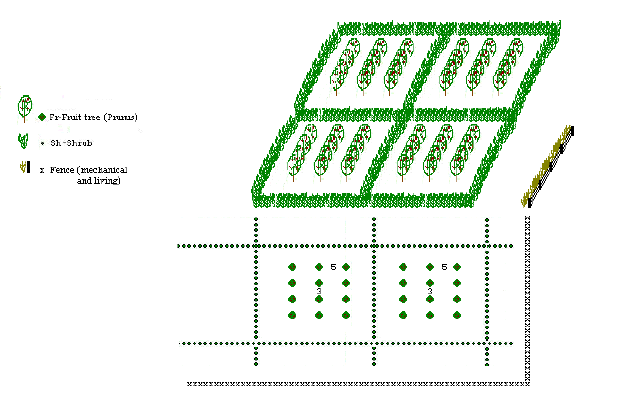
1. Suitable site class: 4 - degraded sandsheet/dunes with groundwater level at more than 4m, combined with rapidly degrading original sandsheet with dark topsoil: remnants of the original "savanna"-like elm woodland, extensive open blocks of permanent agricultural land and traditional communal grazing lands.
2. Description: This model proposes patches (small blocks) of almond trees and seabuckthorn in natural grassland.
3. Objectives: Environmental protection, restoration of natural grassland with eventually a cash crop production (almonds and seabuckthorn berries).
4. Design: Small blocks of Prunus armeniaca (12 trees), planted 3 x 5 m in the blocks alternated with blocks of Hippophea 16 trees), planted at 3 x 3 m, distanced from each other by blocks of 10 m. Crossed belts of 2 rows of Lespedeza, 1m apart in the row, could be installed in between the patches. Design will be irregular and depend on the spatial distribution of suitable micro-sites. Mechanical fencing has to be included in the model in order to protect the natural regeneration of the grassland against grazing animals. Living fences should be installed in order to replace the mechanical fence after a few years.
5. Species to be used: Prunus armeniaca var.ansu (provenance of Zhalute Banner), Hippophea rhamnoides (adapted provenances), shrubs as Lespedeza bicolor, ... and living fence species as Caragana microphylla, Gleditsia japonica, Hemiptelea davidii, ...
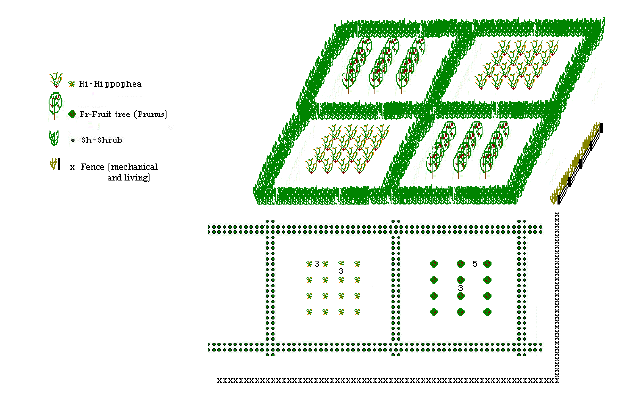
1. Suitable site class: 4 - degraded sandsheet/dunes with groundwater level at more than 4m, combined with rapidly degrading original sandsheet with dark topsoil: remnants of the original "savanna"-like elm woodland, extensive open blocks of permanent agricultural land and traditional communal grazing lands.
2. Description: This model proposes small block plantations of pines on selected sites, intercalated with broadcast sown shrubs.
3. Objectives: Environmental protection, restoration of natural grassland with eventually some wood and fodder production.
4. Design: Block plantations of different selected provenances of pines planted in patches (9 trees) intercalating with broadcast sown shrubs in crossed belts. Design will be irregular and depend on the distribution of suitable micro-sites for pines (groundwater table not to deep, non-alkaline soils...). Mechanical fencing has to be included in the model in order to protect the natural regeneration of the grassland against grazing animals. Living fences should be installed in order to replace the mechanical fence after a few years.
5. Species to be used: different selected provenances and species of Pinus, leguminous shrubs as Caragana, Hedysarum, for the broadcast sowing, and living fence species as Caragana microphylla, Gleditsia japonica, Hemiptelea davidii, ...
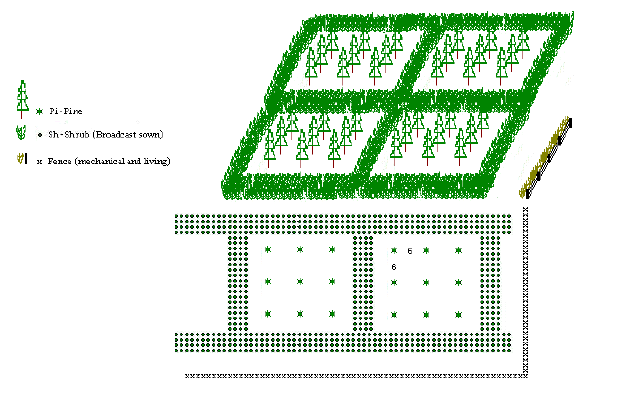
1. Suitable site class: 2 and 3 where moving sand dunes are invading.
2. Description: This model proposes poplar plantations in wide spread small blocks, intercalated with patches of fruit trees on selected sites and broadcast sown shrubs in between.
3. Objectives: Environmental protection, restoration of natural grassland with eventually some wood and fruit production.
4. Design: Plantations in wide-apart blocks of different selected clones of poplars planted in patches (9 trees), intercalated with small blocks of fruit trees (Prunus armeniaca - 25 trees) and broadcast sown shrubs in crossed belts in between the blocks. Design will be irregular and depend on the distribution of suitable micro-sites for fruit trees (water table not too deep, suitable soil...). Mechanical fencing has to be included in the model in order to protect the natural regeneration of the grassland and the plantation against grazing animals. Living fences should be installed in order to replace the mechanical fence after a few years.
5. Species to be used: different selected clones of poplar, selected provenances of Prunus armeniaca, leguminous shrubs as Caragana or Hedysarum for broadcast sowing, and living fence species as Caragana microphylla, Gleditsia japonica, Hemiptelea davidii, ...
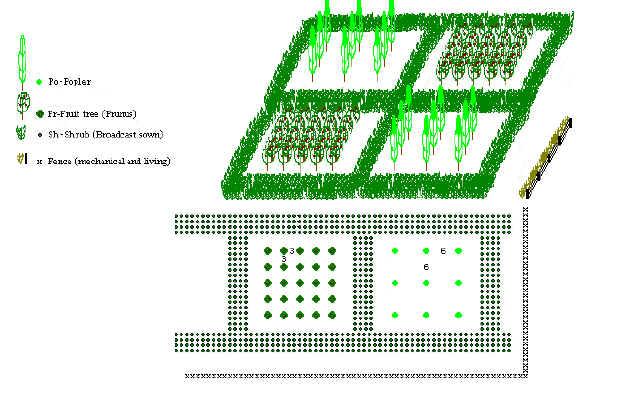
1. Suitable site class: 4 - on moving sand dunes.
2. Description: This model proposes willow plantations in wide spread small blocks, intercalated with patches of fruit trees on selected sites and broadcast sown shrubs in between.
3. Objectives: Environmental protection, restoration of natural grassland with eventually some wood and fruit production.
4. Design: Wide spread block plantations of willow planted in patches (9 trees) intercalating with small blocks of fruit trees (Prunus armeniaca - 25 trees) and broadcast sown shrubs in crossed belts in between the blocks. Design will be irregular and depend on the distribution of suitable micro-sites for fruit trees (water table not to deep, soil...). Mechanical fencing has to be included in the model in order to protect the natural regeneration of the grassland against grazing animals. Living fences should be installed in order to replace the mechanical fence after a few years.
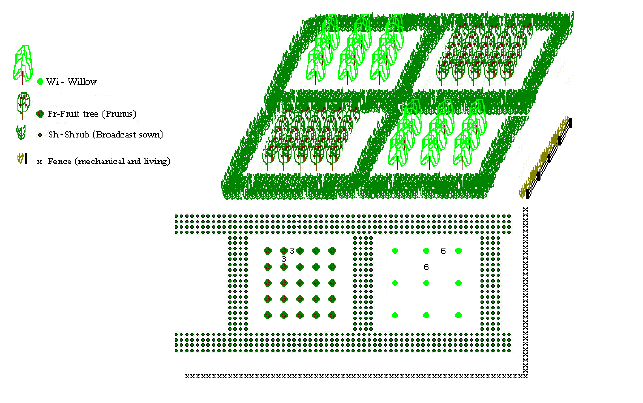
5. Species to be used: selected clones and provenances of Salix gordejevii and Prunus armeniaca, leguminous shrubs as Caragana or Hedysarum for broadcast sowing, and living fence species as Caragana microphylla, Gleditsia japonica, Hemiptelea davidii, ...
1. Suitable site class: 4 - degraded sandsheet/dunes with groundwater level at more than 4m, combined with rapidly degrading original sandsheet with dark topsoil: remnants of the original "savanna"-like elm woodland, extensive open blocks of permanent agricultural land and traditional communal grazing lands.
2. Description: This model proposes small block plantations of elms on selected sites, intercalated with broadcast sown shrubs.
3. Objectives: Environmental protection, restoration of natural elm woodland with eventually some fodder production.
4. Design: Block plantations of different selected provenances of elms planted in patches (9 trees) intercalating with broadcast sown shrubs in crossed belts. Design will be irregular and depend on the distribution of suitable micro-sites for elms (groundwater level not to deep, soils...). Mechanical fencing has to be included in the model in order to protect the natural regeneration of the grassland against grazing animals. Living fences should be installed in order to replace the mechanical fence after a few years.
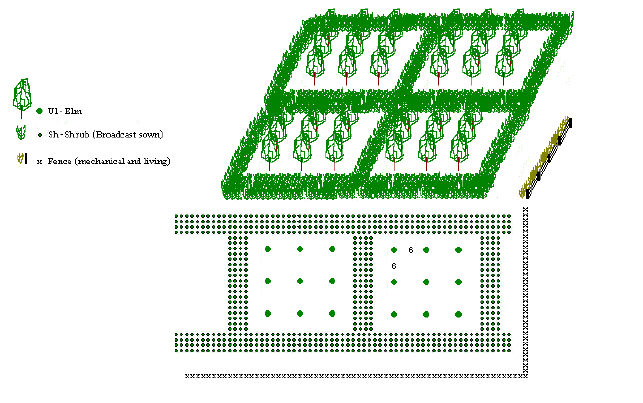
5. Species to be used: different selected provenances and species of elms, leguminous shrubs as Caragana, Hedysarum, ... for broadcast sowing, and living fence species as Caragana microphylla, Gleditsia japonica, Hemiptelea davidii, ...
1. Suitable site class: 4 - on moving sand dunes.
2. Description: This model proposes revegetation of moving sand dunes with broadcast sown shrubs.
3. Objectives: Environmental protection, restoration of natural grassland with eventually some fodder production.
4. Design: Broadcast sown shrubs in a grid of crossed belts. Mechanical fencing has to be included in the model in order to protect the natural regeneration of the grassland against grazing animals. Living fences should be installed in order to replace the mechanical fence after a few years.
5. Species to be used: leguminous shrubs as Caragana, Hedysarum, for the broadcast sowing, and living fence species as Caragana microphylla, Gleditsia japonica, Hemiptelea davidii, ...

1. Suitable site class: 4 - on moving sand dunes.
2. Description: This model proposes natural revegetation of moving sand dunes just by fencing off.
3. Objectives: Environmental protection, restoration of natural grassland with eventually some fodder production.
4. Design: Mechanical fencing in order to protect the natural regeneration of grassland on the sand dunes against grazing animals. Living fences should be installed in order to replace the mechanical fence after a few years.
5. Species to be used: living fence species as Caragana microphylla, Gleditsia japonica, Hemiptelea davidii, ...
